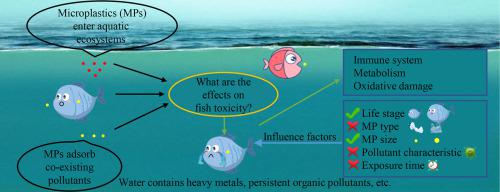Water Research ( IF 11.4 ) Pub Date : 2023-05-21 , DOI: 10.1016/j.watres.2023.120113 Feng Yuan 1 , Hongyu Chen 2 , Yongcheng Ding 1 , Ying Wang 1 , Qihang Liao 2 , Teng Wang 3 , Qinya Fan 2 , Ziyue Feng 1 , Chuchu Zhang 1 , Guanghe Fu 2 , Xinqing Zou 2

|
Aquatic ecosystems are among the main destination for microplastics (MPs) in the environment. MPs that enter aquatic ecosystems can contribute to pollution together with other co-existing pollutants. However, whether such pollution results in higher or lower toxicity to fish than that caused by co-existing pollutants alone remains controversial. This study aimed at closing this research gap based on 1380 biological endpoints under the background of environmental MP concentrations collected from 55 laboratory studies. Overall, MPs in co-existing pollutant solutions significantly increased the toxicity to fish. Specifically, MPs elevated negative effects on the immune system, metabolism, and oxidative damage. Subgroup analysis indicated that changes in toxicity were related to fish life stage and MP size, but not to co-existing pollutant or MP type. Meta-regression analysis indicated that changes in toxicity were not related to the logarithm of the octanol–water partition coefficient (logKow) or exposure time. Finally, the differences between laboratory research and the actual aquatic environment were discussed from four aspects: MPs, co-existing pollutants, environmental factors, and experimental objects. Our study provides a basis for further understanding the potential impact of MPs on aquatic organisms from a combined pollution perspective. Moreover, our results can provide a reference for the conservation and management of aquatic ecosystems.
中文翻译:

微塑料对共存污染物对鱼类毒性的影响:荟萃分析
水生生态系统是环境中微塑料 (MP) 的主要目的地之一。进入水生生态系统的 MP 会与其他共存污染物一起造成污染。然而,这种污染对鱼类的毒性是否高于或低于仅由共存污染物引起的毒性仍存在争议。本研究旨在基于从 55 项实验室研究中收集的环境 MP 浓度背景下的 1380 个生物学终点来缩小这一研究差距。总体而言,共存污染物溶液中的 MP 显着增加了对鱼类的毒性。具体而言,MPs 增加了对免疫系统、新陈代谢和氧化损伤的负面影响。亚组分析表明,毒性变化与鱼类生命阶段和 MP 大小有关,但与共存污染物或 MP 类型无关。元回归分析表明,毒性变化与辛醇-水分配系数 (logKow) 的对数或暴露时间无关。最后从MPs、共存污染物、环境因素、实验对象四个方面讨论了实验室研究与实际水环境的差异。我们的研究为从综合污染的角度进一步了解 MPs 对水生生物的潜在影响提供了基础。此外,我们的研究结果可为水生生态系统的保护和管理提供参考。从MPs、共存污染物、环境因素、实验对象四个方面讨论了实验室研究与实际水环境的差异。我们的研究为从综合污染的角度进一步了解 MPs 对水生生物的潜在影响提供了基础。此外,我们的研究结果可为水生生态系统的保护和管理提供参考。从MPs、共存污染物、环境因素、实验对象四个方面讨论了实验室研究与实际水环境的差异。我们的研究为从综合污染的角度进一步了解 MPs 对水生生物的潜在影响提供了基础。此外,我们的研究结果可为水生生态系统的保护和管理提供参考。











































 京公网安备 11010802027423号
京公网安备 11010802027423号